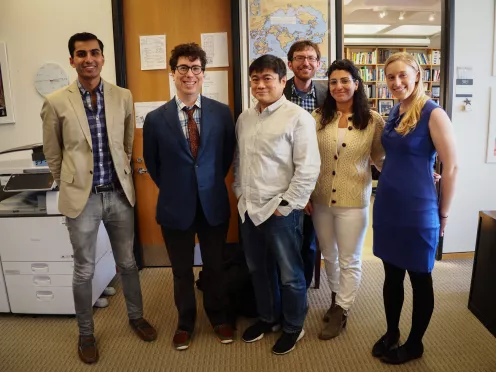
For the first time, Harvard Law School and the MIT Media Lab have collaborated to host an innovative January-term course, “Internet & Society: The Technologies and Politics of Control,” dedicated to understanding the legal and technical dynamics of the digital world.
Harvard Law School Professor and co-founder of the Berkman Klein Center Jonathan Zittrain ’95 and Director of the MIT Media Lab Joi Ito led students through a nine-day course focused on the internet’s architecture, and the ways law and regulation influence online activity. Continuing a reputation for innovation in teaching, Zittrain first conceived of the course as a means of grounding important, but abstract technological and legal concepts in real-world understanding.
“Law is neither made nor applied in a vacuum, and the digital environment itself, shaped by those who write its software, can be made more or less amenable to regulation and intervention,” said Zittrain. “The conflicts we explored in the course had parties from across the spectrum, with varying interests and with disparate tools for addressing them.”
Capitalizing on the interdisciplinary ecosystem available in Cambridge, the course invited students from Harvard Law School, the MIT Media Lab, the Berkman Klein Center, and technology industry professionals, to cover topics from cryptocurrencies to the governance of artificial intelligence. In discussions with Ito about potential issues for the course, Zittrain agreed the course would not focus on a single topic, but instead survey a grand list of subjects to showcase the complex evolution of the internet, and the interactions between various players.
To tie the disparate subjects together, the course revolved around two main themes. Harvard Law School Professor Lawrence Lessig’s model of the four forces of regulation (laws, norms, markets, and architecture) helped to frame discussions around topics like the internet’s architecture of the future of artificial intelligence. Zittrain’s emphasis on the point that technology falls on a spectrum ranging between owned technology — proprietary devices that are locked-down, and not open to tinkering — and unowned helped to bridge conversations about the evolution of devices technical development and their regulation.
In fusing these themes with the practical experience of industry professionals in the classroom, the course pushed students who are often siloed in their own disciplines to expand the boundaries of their thinking.
“For engineers the law seems … predetermined and fixed,” said Ito, “when in fact it turns out people argue and it’s squishy and it’s complicated, and very much a dynamic system. And similarly lawyers think of software as take it or leave it … But it’s like putty, you can make it do what you want.”
The makeup of the students facilitated nuanced discussions of technical, legal, and societal arcs that would not have been possible otherwise.
“I had never taken a class that brought together such a unique cross-section of people,” said Nomi Conway, one of the tech industry professionals in the course as part of the Berkman Klein Assembly and a product manager at Square. “Having these very unique perspectives in the room made for fascinating discussions and forced all of us to think through problems from new and different vantage points.”
The course was also sprinkled with a star-studded cast of guest speakers who grounded the abstract concepts in real-world situations. As the class debated the balance between free speech online and the use of social media platforms to harass and bully, Andover Headmaster and former Harvard Law Professor John Palfrey ’01 talked about a past case where his high school students had used a new social media platform to rate the attractiveness of their peers. Together, students parsed out how the course’s themes could apply to the case.
“The guest speakers were always experts in whatever the day’s topic was, and so we got a window into how the technical and policy issues we were learning about played out in the real world,” said Daniel Etcovitch ’18. “The combination of Professors Zittrain and Ito really highlights the combination of the dual legal and technology aspects of the class.”
After completing readings about the role of private intermediaries in surveilling the public, students were joined by Berkman Klein Fellow and former National Security Agency Director of Compliance John DeLong and renowned cybersecurity technologist Bruce Schneier to discuss the NSA’s shifting role as norms around privacy and government surveillance changed post-9/11 and post-Snowden. And in a surprise visit on the last day of course, founder of the World Wide Web Tim Berners-Lee appeared on video to tell students about his inspiration for the internet, and his vision for its future.
The Internet & Society course was part of the Berkman Klein Assembly, a larger program that gathers technology industry professionals to work towards building solutions to major technological problems. The group will be dedicating the next few months to developing solutions to issues in digital security.
“It’s too easy to get stuck in hardened positions of ‘technology’ versus ‘legal system,’” said Bobo Bose-Kolanu, a member of the Assembly cohort. “But the problems of internet governance are thick and multidimensional, and will require the best from all disciplines.”
This article originally appeared on Harvard Law Today.

